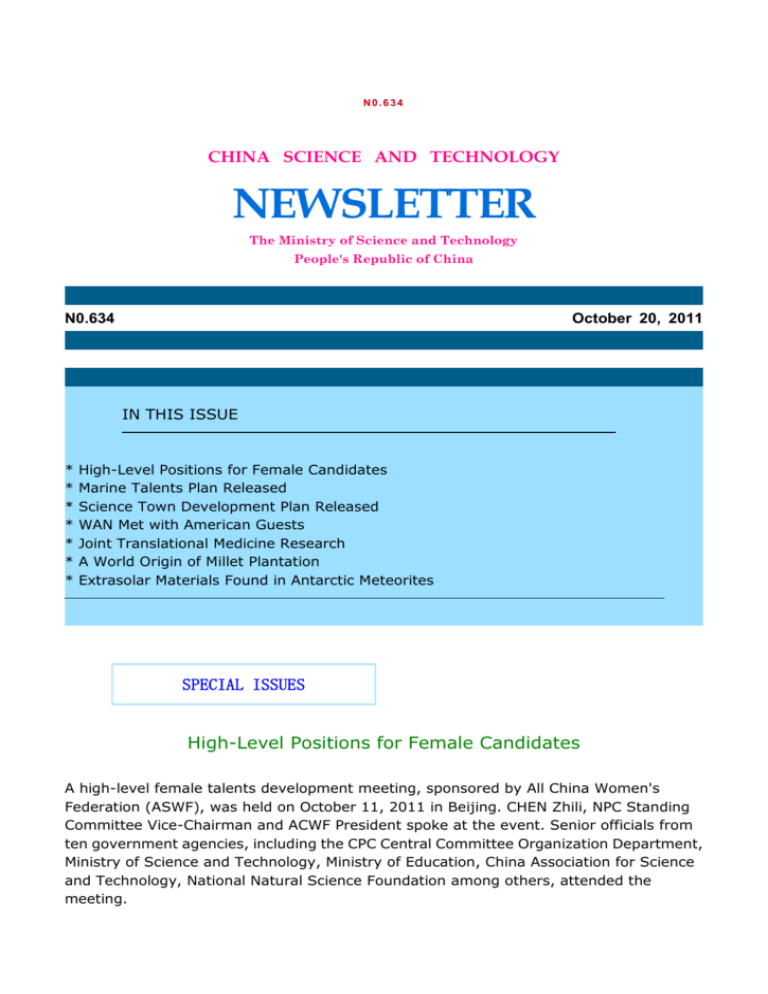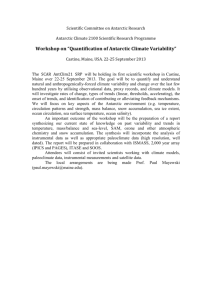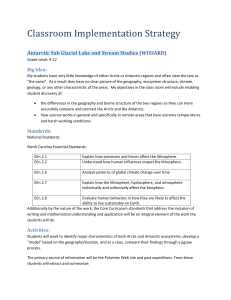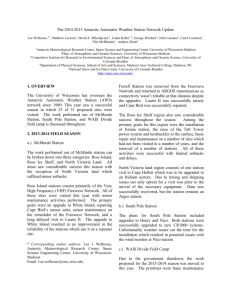translational husbandry
advertisement

N0.634 CHINA SCIENCE AND TECHNOLOGY NEWSLETTER The Ministry of Science and Technology People's Republic of China N0.634 October 20, 2011 IN THIS ISSUE * * * * * * * High-Level Positions for Female Candidates Marine Talents Plan Released Science Town Development Plan Released WAN Met with American Guests Joint Translational Medicine Research A World Origin of Millet Plantation Extrasolar Materials Found in Antarctic Meteorites SPECIAL ISSUES High-Level Positions for Female Candidates A high-level female talents development meeting, sponsored by All China Women's Federation (ASWF), was held on October 11, 2011 in Beijing. CHEN Zhili, NPC Standing Committee Vice-Chairman and ACWF President spoke at the event. Senior officials from ten government agencies, including the CPC Central Committee Organization Department, Ministry of Science and Technology, Ministry of Education, China Association for Science and Technology, National Natural Science Foundation among others, attended the meeting. Ten government agencies, including All China Women's Federation and Ministry of Science and Technology, jointly launched in January 2010 a high-level female talents development project. Up to date, 10 research reports have been derived from the project, which facilitated the formulation of a range of policies for high-level female talents. For example, female human resources development has become part of China’s 12th Five-Year Planning (2011-2015), and gender issues and female human resources development have become a focus in the outlines defined for preparing national medium and long term development plans. At the meeting, a range of policies were introduced. The CPC Central Committee Organization Department has reiterated the female retirement age (60 years old) for the position of division chief or above, and defined the female proportion in the management team, and the proportion of female deputies in the National People’s Congress and the Chinese People’s Political Consultative Conference. Shanghai has for the first time put forward a new local retirement policy allowing both male and female employees to be retired at the same age threshold, along with policy support for female cadres and talents. A senior official of National Natural Science Foundation told the audiences that NNSF has rolled out new policies, extending the age of female applicants for the Youth Science Foundation to 40 years old. Meanwhile, female applicants may extend the finishing time of a research project due to giving birth to baby. NNSF also promised to add more female members in its expert review panels. Marine Talents Plan Released Not long ago, the Chinese State Oceanography Bureau, Ministry of Education, Ministry of Science and Technology, Ministry of Agriculture, and Chinese Academy of Sciences jointly released an outline for preparing a national medium and long-term development plan for marine professionals (2010-2020). The Outline pointed out that China will strive to secure a steady growth of its high caliber marine professionals in a time of 10 years, fostering a high quality marine professional contingent with reasonable scale, optimized structure, and rational distribution, enhancing the contributions of marine professionals to the development of China’s marine industry, and making the overall development level of China’s marine professionals reach the intermediate level of major maritime countries in the world. Science Town Development Plan Released Beijing Zhongguancun Science Town Development Planning (2011-2015), jointly prepared by ten government agencies, including Beijing Municipal Economic and Information Technology Commission, was officially released on October 18, 2011. The plan says the Science Town will hatch tens of thousands of "specialized, sophisticated, unique, novel” high-tech startups in the coming five years. It also plans to build the Science Town into an international hub gathering high-end tech professionals and tech startups within the coming 5 to 10 years. By 2015, the Science Town will secure a combined technology, industry, and trade revenues exceeding RMB 1 trillion, enjoying an averaged annual growth rate around 20%. LIANG Sheng, Executive Deputy Chief of Zhongguancun Innovation Platform said Zhongguancun Science Town will be further developed on the combined strength of industry, research institutes, and universities, and on the experience gathered by the Science Town in past years. It will explore the incentives desirable for spurring up the growth of small and medium-sized businesses. INTERNATIONAL COOPERATION WAN Met with American Guests October 13, 2011- WAN Gang, Chinese Minister of Science and Technology met with visiting former U.S. Secretary of State Condoleezza Rice and Applied Materials Chairman & CEO Michael Splinter and his party. The two sides made an in-depth exchange of views on strengthening clean energy cooperation between China and the United States. WAN briefed the other side of China-US cooperation on clean energy technologies and China’s solar energy and semiconductor endeavors in the 12th five-year period. He welcomes US partners, including Applied Materials, to work with their Chinese counterparts on cooperative R&D activities. Dr. Rice said the United States and China have fostered a good cooperation in the field of clean energy, which not only enhanced the bilateral relations, but also benefited other countries in the world. Sprint briefed his Chinese counterparts of the development of Applied Materials R&D Center in Xi'an, especially in the areas of solar energy, semiconductor, factory automation among others, and expressed the willingness to enhance cooperation with China. Joint Translational Medicine Research A ceremony was recently staged by the Peking University Medical School and the University of Michigan Medical School to celebrate the first anniversary of the Institute for Translational Medicine jointly established by the two universities, along with the opening of a translational medicine seminar. At the four-day seminar, Chinese and American scientists exchanged views on a range of topics, including cardiovascular diseases, metabolic diseases among others. The Peking University Medical School and the University of Michigan Medical School established in 2010 an Institute for translational medicine, in a bid to raise the research level in the area. Each party contributed USD 7 million to finance the most promising projects that work on the cutting-edge topics, in an attempt to land major breakthroughs in dealing with some sophisticated diseases. In the past year, the Institute has made laudable progresses in establishing six joint research projects concerning viral hepatitis, obesity, hypertension, coronary artery disease, lung disease, and smoking. Meanwhile, the Institute has created an Ethics Review Committee, and plans to establish a biomedical information platform that takes care of samples and data collection and management. RESEARCH AND DEVELOPMENT A World Origin of Millet Plantation A study team, led by LV Houyuan of CAS Institute of Geology and Geophysics, reported that the scientific identification of the food ash samples excavated from a Neolithic site in Cishan, Wu’an Municipality, Hebei Province shows that the site is not only the birthplace of common millet but also the birthplace of foxtail millet in the world. In this context, China has a foxtail millet growing history dated back to 10,000 years ago. Researchers made the discovery based on the phytolith analysis of different parts and cell layers of modern common and foxtail millet plants. They developed five criteria for identifying the phytolith of common and foxtail millet species. The systematic phytolith and carbon-14 dating analysis of 46 ash samples collected from 5 Neolithic caves in Cishan, and one ash sample stored in the Cishan Museum in different laboratories confirmed that of the food stored in the caves, some are the earlier foxtail millet crops grown about 10000-8700 years ago, and some others are the common millet grown about 8700-7500 years ago. The discovery provides the earliest evidence about people growing both common and foxtail millets in the locality. The collections kept at the Cishan Ruins Museum also show some 6,000 objects unearthed along with the food ash samples, including pottery, stoneware, boneware, mussel ware, animal bones, and plant specimens. The finding provides valuable clues for looking for earlier civilization origins of farming, animal husbandry, and pottery industry in ancient China. Extrasolar Materials Found in Antarctic Meteorites CAS Institute of Geology and Geophysics bought a nano-SIMS from overseas manufacturers, in a bid to have an in-depth study of Antarctic meteorites. While working on the meteorites collected from the Antarctic, researchers spotted extrasolar materials in a meteorite sample marked GRV 021710 (CR2), through minor components isotope scan using nano-SIMS matrix, in an attempt to find the particles with isotope anomalies. Researchers also studied the chemical and mineral composition of the particles showing isotope anomalies using Auger nano-probe. Based on nano-SIMS isotope data and mineral chemical composition data derived from Auger probe, researchers found in CR2 carbonaceous chondrite meteorite a large quantity of extrasolar materials originated from the red giant, AGB stars, and supernova, including silicates, oxides, silicon carbide, and carbon particles (graphite and organic matters). The 442.6-gram GRV 021710 (CR2) meteorite was found on January 20, 2003 in the northern section of the Gust Cliff in the Antarctic Grove Mountains region during China’s 19th Antarctic expedition. Monkey Exome Capturing Array Beijing Genomics Institute (Shenzhen) has recently developed a monkey exome sequencing and analyzing platform, through which researchers may improve their understanding of tiny differences between different monkey genomes, and conduct medicine and disease related researches. The platform is built on two core technologies: monkey exome capturing array (MECA) and the new generation high-throughput sequencing technology. The combination of the two technologies enables researchers to capture the entire monkey exome. ZHANG Jiong, a researcher working for BGI said BGI has initiated a Chinese rhesus macaque (Macaca mulatta) genome project and a Cynomolgus macaque (Macaca fascicularis) genome project. Based on the genomic data generated from the two projects, BGI designed the exome capture array. The array is the only capturing array in the world able to capture monkey exome. Telescope for Antarctic Expedition China’s first proprietary unattended “Antarctic Survey Telescope" was commissioned for future use on October 14, 2011 at the Purple Mountain Observatory Xuyi site. The telescope will become part of China’s 28th Antarctic expedition to prove extrasolar planets and supernovae. According to a briefing, the telescope is 68cm across, with an effective observation diameter at 50cm, and a resolution of 1 arc second. Equipped with the world's largest single-chip charge-coupled device (CCD), it is able to observe the sky of a size of nine suns combined in a round-the-clock manner. The observational data can be stored on-site, with partial data being sent back to the home station. The telescope’s lens, structure, and material used have a special design touch for working in an extreme Antarctic environment. The telescope, with a primary mirror having an automatic defrost system, becomes more compact for easier delivery, thank to an improved optical structure, and to the lighter materials used, including low temperature steel and low expansion materials. Other components, such as transformer and electronic control gear, are also tailored to meet Antarctic cold environment. The system supports remote control and unattended observation. Nitride Phosphor Synthesized Using Microwave Not long ago, CAS Ningbo Institute of Material Technology and Engineering researchers successfully prepared high quality nitride phosphor under low temperature and regular pressure. The high quality nitride phosphor passed fluorescence property tests in August. The new technology turned microwave power into heat energy, enabled a balanced heating. Comparing with the traditional high pressure synthesis process featured with high temperature (1700℃-2000℃) and high pressure (1 to 10 atm), the microwave synthesis process is able to achieve the same results under normal atmospheric pressure and at a temperature of 1600℃. In addition, low-temperature synthesis enhances the optical properties of phosphors, enjoying an energy saving up to 80%. Furthermore, under the same reaction temperature, the microwave synthesis process would see a raised quantum efficiency of phosphor by 1.6 times, compared with the traditional process. Additionally, a regular air furnace yields only 100 grams of phosphor a day, while the microwave process is able to hit the level of tens of kilograms a day. The new technology is applicable for zero gradient large area even heating, enjoying a fast temperature rise and a short reaction time, desirable for producing the powder with evenly distributed particles. NEWS BRIEFS Largest Movable Radio Telescope SUN Zhengwen, deputy head of CAS Xinjiang Observatory recently told reporters that the 110-meter radio telescope project, the largest of its kind in the world jointly staged by the Xinjiang Autonomous Region and the Chinese Academy of Sciences is proceeding smoothly. The collaborators have chosen the Banjiegou Shihezi Village in Qitai County, Changji Prefecture, Xinjiang as the preliminary site. Researchers are currently working on a feasibility study for the site. SUN said the 110-m radio telescope, designed to reach an internationally advanced level, can be employed to conduct high-precision pulsar observational study, thanks to its large enough diameter. The telescope will eventually be used to understand compact objects, detect gravitational waves, and probe black holes, boosting China’s capability of astronomical observation and theoretical astronomy, and accommodating China’s needs in deep space probe, defense, and national economic development. World First Permanent Maglev Rotary Mechanism A permanent maglev bearing turbine, designed by Jiangsu University, and jointly manufactured by Suzhou Shenhua Cryogenic Equipment and Jiangsu University Mechanical and Electrical Plant, recently passed a full-load test, with the initial speed hitting the level of 20,000 rev/min. Thanks decade painstaking efforts, a team of researchers led by Prof. QIAN Kunxi at Jiangsu University introduced the gyroscopic effects of permanent maglev rotation into an artificial heart pump in a bid to achieve the desired equilibrium. Experiments show that the permanent maglev rotary mechanism, when reaching a given speed, can produce the gyroscopic effects in a stable suspension. Under a dynamic condition, the greater the permanent maglev rotation is, the more stable the rotation can be. The finding, granted with three national patents, laid a ground work for the further improvement and commercial applications of permanent maglev rotary mechanism. Comments or inquiries on editorial matters or Newsletter content should be directed to: Department of International Cooperation, MOST 15B, Fuxing Road, Beijing 100862, PR China Tel: (8610)58881360 Fax: (8610) 58881364 http://www.most.gov.cn






